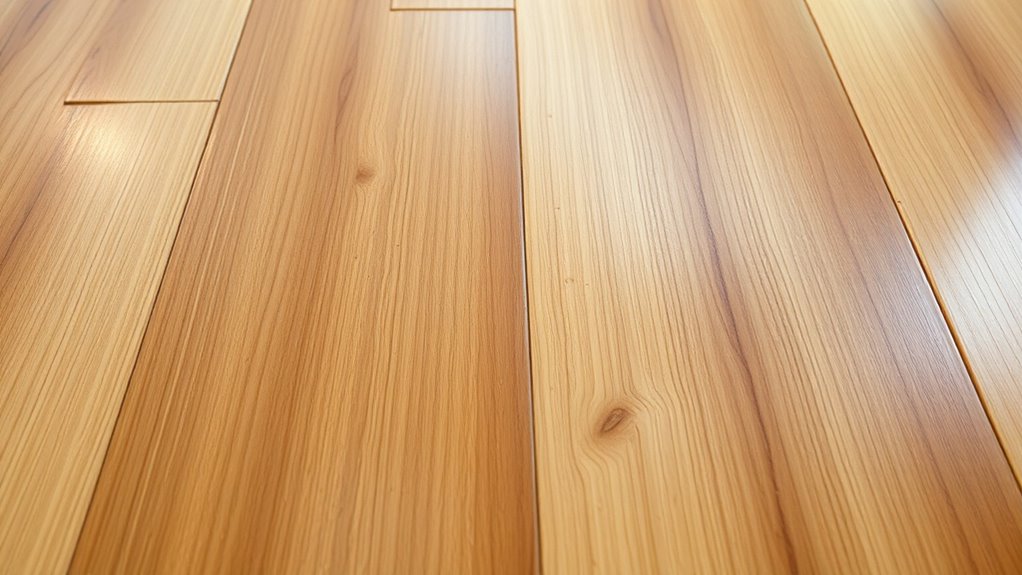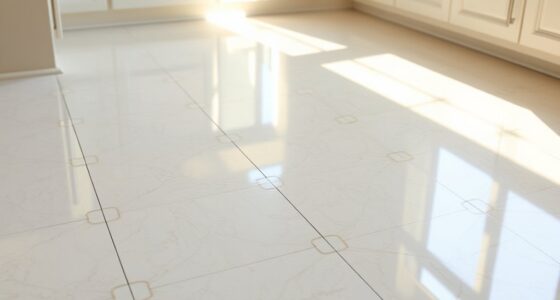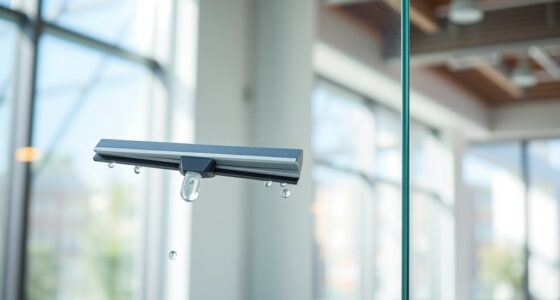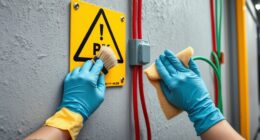For bamboo floors, a dry mop is best for removing dust and loose dirt, keeping the surface clean without damage. Use a damp mop only for sticky spots or stains, but make sure it’s just slightly moist and well-wringed to prevent water spots or warping. Avoid over-wetting the floor, especially with finishes that are sensitive to moisture. Want to guarantee your floors stay their best? Keep exploring for more tips.
Key Takeaways
- Use a dry microfiber mop for regular dust and debris removal to prevent scratching.
- Employ a damp mop for stubborn stains or sticky spots, ensuring the cloth is just lightly moist.
- Avoid over-wetting the floor to prevent warping, especially on unsealed or poorly finished bamboo surfaces.
- Always wring out excess water before damp mopping and follow with a dry cloth if needed.
- Choose cleaning methods based on the surface finish—glossy or matte—to preserve the floor’s appearance.
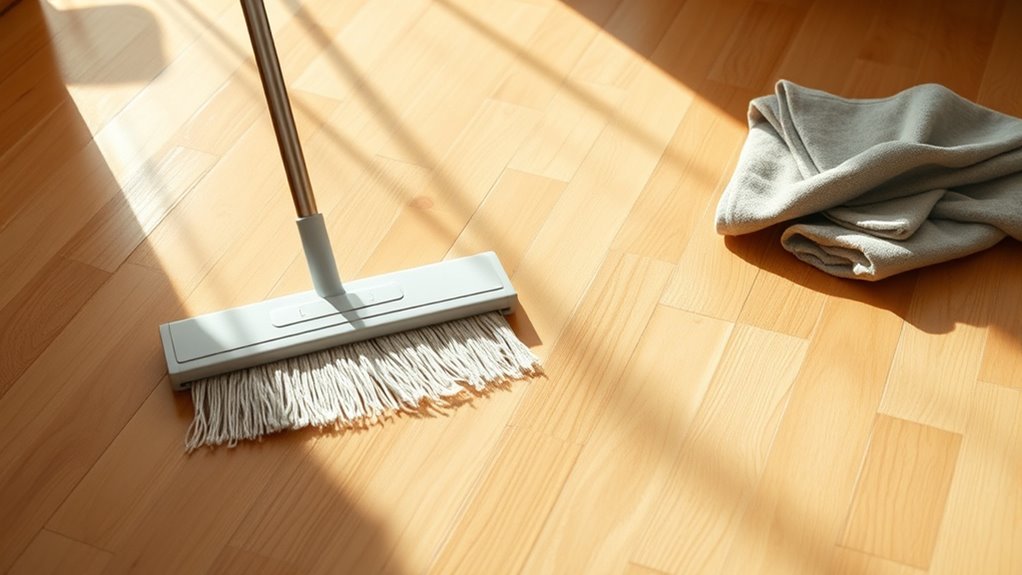
Are you considering a stylish and eco-friendly flooring option? Bamboo floors are an excellent choice, combining durability with sustainability. But to keep them looking their best, you need to master the right cleaning techniques. One common question is whether to use a dry or damp mop, and knowing when and how to do each can make a big difference in maintaining your bamboo floors’ beauty and longevity.
When it comes to cleaning techniques, using a dry mop is often your first line of defense. A microfiber dust mop or a soft broom can effectively pick up dust, dirt, and debris without introducing excess moisture. Regular dry cleaning prevents grit from scratching the surface and keeps the surface finishes intact. If you notice smudges or sticky spots, a slightly damp mop can be used, but it’s paramount to avoid over-wetting. Excess moisture can seep into the bamboo and cause warping or swelling, especially if your surface finishes aren’t sealed thoroughly. That’s why understanding surface finishes is vital—glossy, matte, or satin finishes each respond differently to moisture. A glossy surface might hide scratches better but can show water spots if not cleaned properly, while matte finishes may require gentler cleaning to prevent dulling.
When using a damp mop, ensure it’s just lightly moist, not soaked. Wring out all excess water before applying it to the floor. Use a mild, pH-neutral cleaner designed specifically for bamboo or hardwood floors. This helps preserve the surface finishes and prevents any chemical damage that could dull the sheen or cause discoloration. Avoid harsh chemicals, abrasive scrubbers, or steam mops, which can strip or damage the surface finishes over time. Regularly changing your cleaning cloth or mop head guarantees you’re not spreading dirt around, which can scratch or dull the surface. Additionally, choosing a self-watering plant pot with a reservoir system can help maintain indoor humidity levels, reducing the risk of bamboo warping due to dryness.
Knowing when to switch from a dry to a damp mop depends on the level of dirt and the type of mess. Light dust and dry debris are best tackled with a dry mop, while deeper, sticky, or stubborn stains may require a damp cloth. Always follow up with a dry cloth to remove any residual moisture, especially if your bamboo flooring has a matte or semi-matte surface finish, which can be more susceptible to water spots. Proper cleaning techniques extend the life of your bamboo floors and keep their surface finishes looking vibrant. Regular maintenance, using the right tools, and understanding your floor’s surface finishes ensure your bamboo flooring remains beautiful and eco-friendly for years to come.
Frequently Asked Questions
Can I Use Vinegar to Clean Bamboo Floors?
You can use vinegar cleaning for bamboo floors, but you should do so cautiously. Vinegar is a natural remedy, but it’s acidic and may damage the finish over time. If you choose to use vinegar, dilute it well with water and apply it damp, not soaked. Always test in a small area first, and avoid harsh cleaning agents to keep your bamboo floors looking their best.
How Often Should I Dry Mop Bamboo Floors?
You should dry mop your bamboo floors at least twice a week to maintain their appearance. Regular cleaning frequency helps prevent dirt buildup, which can scratch the surface. Incorporate simple maintenance routines like quick dry mops after spills or daily dusting to keep your floors looking their best. Studies show that consistent cleaning extends the life of bamboo flooring by up to 30%, making routine dry mopping an essential part of your upkeep.
Are Steam Mops Safe for Bamboo Flooring?
Steam mops can be risky for bamboo flooring because the heat and moisture may damage the finish or cause warping. For floor safety, it’s better to avoid steam cleaning on bamboo floors. Instead, opt for a damp mop with a gentle cleaner, ensuring you don’t use excessive water. This approach helps keep your bamboo floors clean while maintaining their integrity and appearance.
What Type of Microfiber Cloth Is Best for Bamboo?
You should choose a soft, lint-free microfiber cloth for bamboo floors, as not all microfiber types are appropriate. Microfiber cleaning cloths made from split fibers are best because they trap dirt effectively without scratching the surface. Avoid rough or abrasive types that can damage bamboo. Using a high-quality, gentle microfiber cloth ensures you clean thoroughly while protecting your bamboo flooring from scratches and wear.
Can I Use a Regular Wet Mop on Bamboo Floors?
You can use a regular wet mop on bamboo floors, but you should be careful with the mop technique and cleaning frequency. Avoid saturating the floor with excess water, as too much moisture can damage bamboo. Instead, use a damp mop and clean regularly to prevent dirt buildup. This approach helps protect your flooring while keeping it clean and shiny without risking warping or swelling.
Conclusion
Think of your bamboo floors as a delicate garden that needs just the right touch. Using a dry mop keeps them safe from grime, like a gentle breeze protecting fragile petals. When they need a little extra cleaning, a damp mop can revive their shine — but only in moderation. By choosing the right approach, you’re tending to your floors like a caring gardener, ensuring they stay beautiful and vibrant for years to come.
